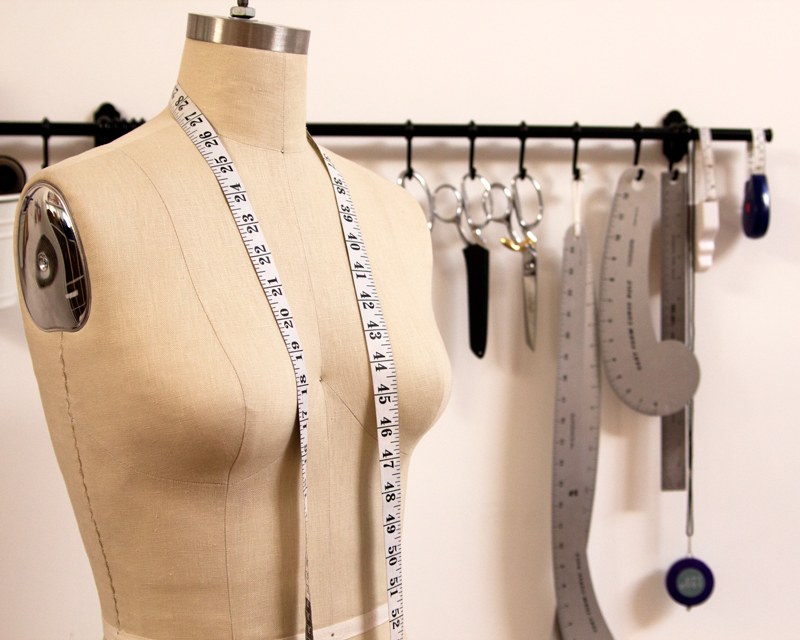
In this post we will be covering general pattern adjustments that can be made to the garment before sewing a muslin. These adjustments include blending between sizes, lengthening, and shortening.
Though making flat pattern adjustments can improve the overall fit of your garment, nothing can do the job quite like a sewing a muslin. If you want a predictable outcome when it comes to fit, always make a muslin!
Next week, we will go over Lengthening the Bodice, Bust Adjustments, and Shoulder Adjustments.
Taking Measurements
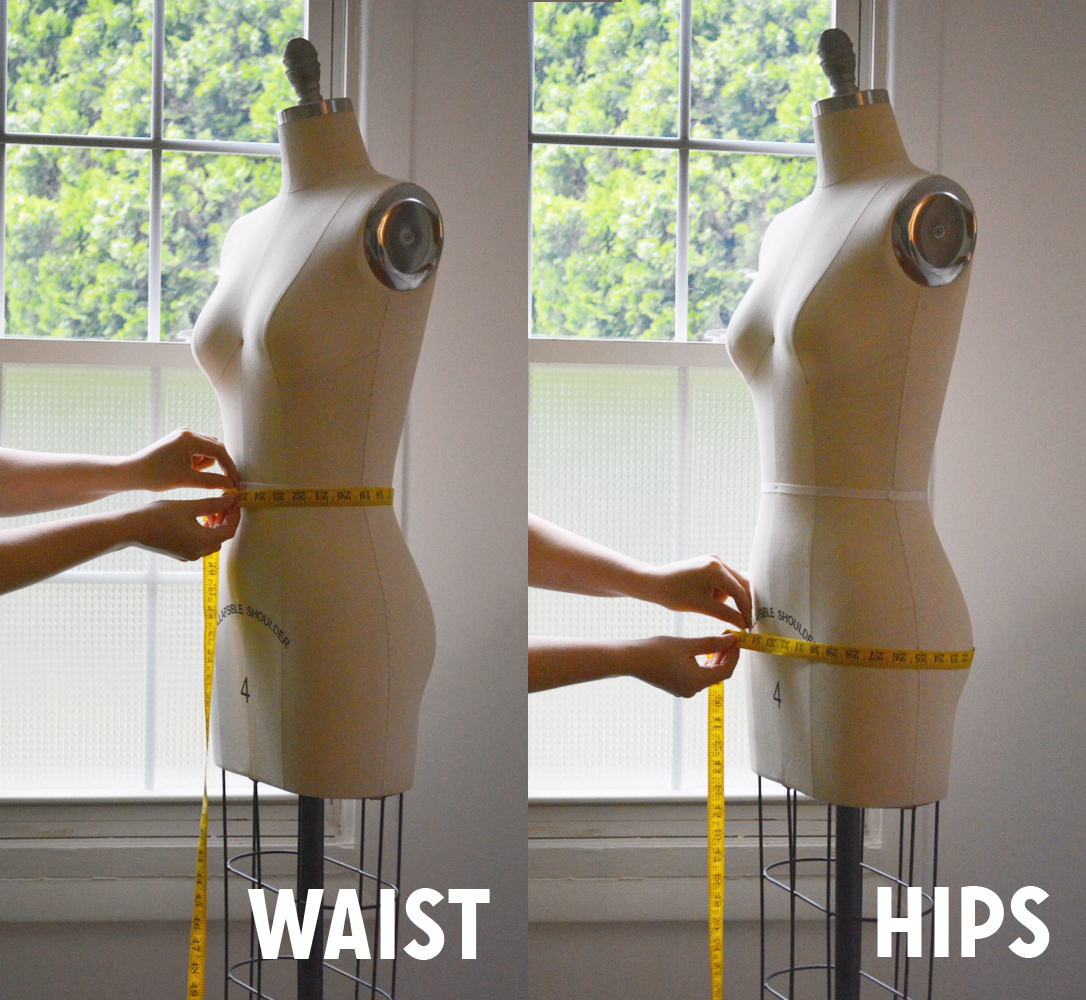
Using a tape measure and wearing undergarments or non-bulky clothing, take your waist and hip measurements. Your waist is the narrowest part of you, usually where you crease when you bend to the side. Your hips are the widest part of you below the waist, generally about 8-10″ below the waist. Make sure the tape measure is parallel to the floor and snug but not digging in.
Make a note of your measurements and see where you fall on the size chart. It’s ok if you are in different sizes for your waist and hips – in a moment we’ll go over how to blend sizes.
Understanding Ease
Ease is the difference between your actual body measurements and your finished garment measurements. It allows for movement and general comfort. The type of fashion fabric used will determine the amount of wearing ease needed in a garment. If a tightly woven fabric with little “give” is used for a fitted dress, more ease would be needed to allow for adequate movement, compared to the same dress being made from a double cotton gauze. Rue is designed for a large range of fabric types and weights. To accommodate this, a larger amount of ease has been added to each size.
How much wearing ease do you need?
Ease amounts are a personal choice. Each person has their own preferences when it comes fit and wearing ease. For instance, I have a small bust and hate having lots of ease in the bust of my garments, it always seems to give me “baggy boobs.” But, I do love the way my Dahlia fits in the bust, which has 1 1/2″ ease. I shoot for that amount of ease in the bust when I’m sewing up a mid-weight dress.
The easiest way to determine what amounts of ease you like, check out a pattern you’ve sewn up before or even a RTW dress in your closet. Your reference dress should also be fitted and made in a similar fabric to your Rue fabric. Cross reference your measurements and the dress’ measurements to determine a starting point for the ease amount of your Rue. It’s a safer bet to add too much rather than too little, reference the minimum ease chart to make sure your not going overboard.
Choosing a Size
When choosing a size in a fitted dress, it’s always a better bet to base your size selection off of the waist measurement rather than the bust. If your bust doesn’t fall into the same category as your waist, you most likely will need a FBA or SBA. If your hip measurement is not in the same size category as the waist, you’ll need to grade at the hip. To start off knowing that the waist fits, your bust and hip alterations will go much more smoothly.
Also, if you are sewing up your Rue in a lighter fabric, or if you are between sizes, I suggest choose one size down from what the pattern suggests.
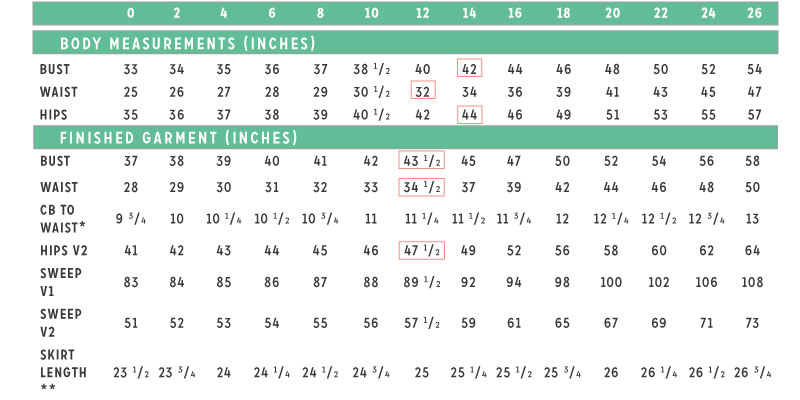
For example, Haley’s measurements are:
Bust: 42.5
Waist: 33
Hip: 45
Technically, she falls somewhere between 12 and 14.
On the finished measurement chart, the waist measurement at size 14 is 37″, which would give Haley 4″of ease. That’s just too much. It is a better choice to size down to size 12, which will give her 2 1/2″ of ease. She will need to do a full bust adjustment, but she always has to do a full bust adjustment ;)
If you are the same size at the waist and hip, you can go ahead and either cut out or trace your pattern pieces. Tracing takes extra time, but it can be good to have an unaltered original in case you end up making any pattern adjustments that don’t work out and you want to start over.
Blending Sizes
If you are falling into different size categories for your waist and hips, one simple fix that you can do before you even make a muslin is to grade your paper pieces between sizes while cutting them out.
In Rue, the only measurements that can be blended are from waist to hip. The Bust Adjustments for Rue require more than just blending, which we’ll cover next Tuesday.
Size blending is ideal for people who find that their hip falls into a larger size than their waist. Luckily this is an easy adjustment we can make to our flat pattern.
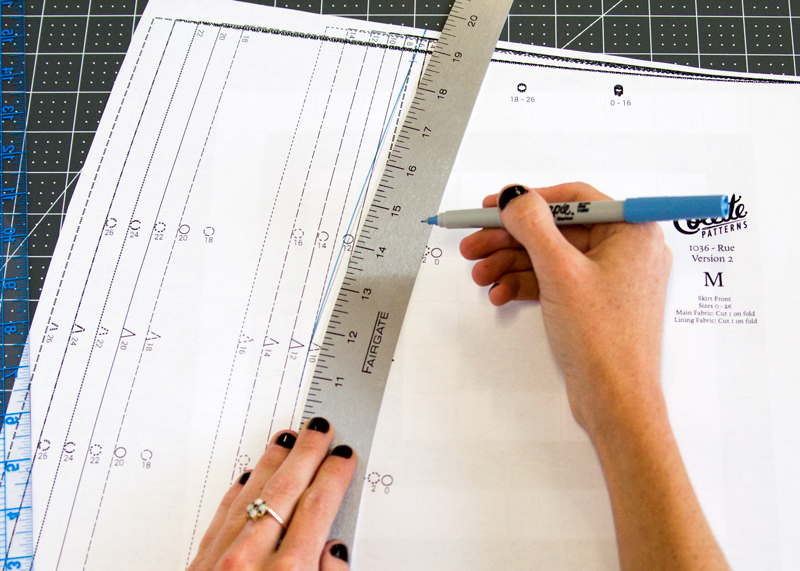
To go to a different size from waist to hips, start at the waist edge of the skirt pieces and use a ruler to blend out to the new size line at the hips. The hip measurement is always at the first notch of the side seam.
Repeat this step for Skirt pieces D, E, and F for Version 1 and J, M, and N for Version 2.
Lengthen and Shortening the Skirt or Sleeve
Since we are all different shapes and sizes, you may need to lengthen or shorten a pattern piece—for instance, if you have shorter or longer legs than average. You don’t want to just add or subtract length from the edges because this will change the length of those edges and the proportions of the garment.
We will learn to lengthen and shorten the bodice next week when we discuss Bust Height Adjustment.
First, to determine whether or not you need to lengthen or shorten, look on the fabric yardage chart to see the finished back length. This is the measurement of the length of the skirt at center back. Take a tape measure and pinch it at that measurement. Hold this to your waist at center back and let the ‘0’ end of the tape measure dangle down. Look in a full-length mirror—the end of the tape measure is where the bottom of the skirt will be.
If you aren’t sure, it’s best not to do anything until you’ve made and tried on your muslin.
Shortening
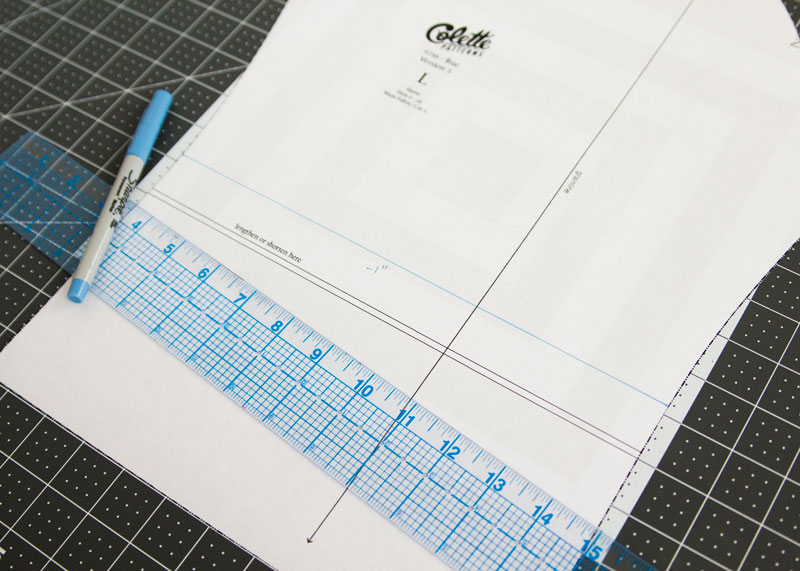
- To shorten a pattern piece, determine how much shorter you’d like it to be. Then use a clear ruler to draw a line this amount above either lengthen/shorten (L/S) line. I shortened the sleeve by 1 inch.
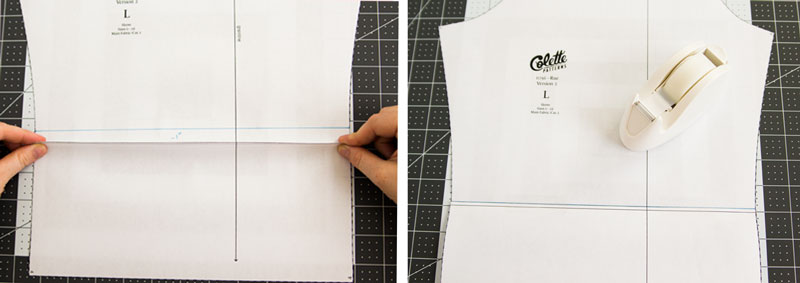
2. Fold the pattern piece along the same L/S line and bring the fold up to meet your drawn line. Tape in place and trim any jagged edges.
Lengthening
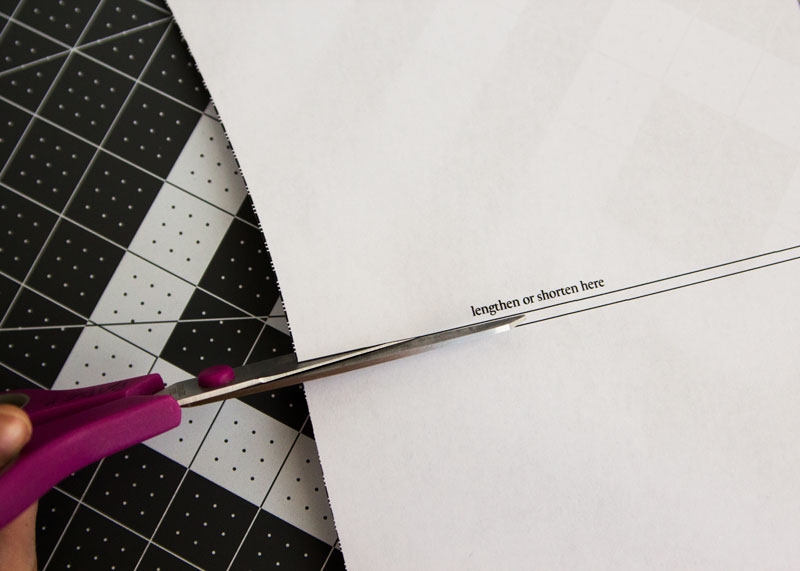
1. To lengthen a pattern piece, cut along the lengthen/shorten lines.
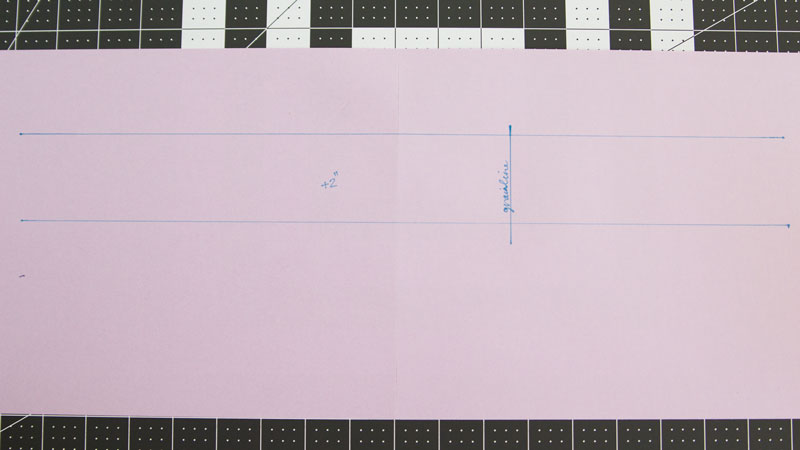
2. On a separate piece of pattern paper draw two parallel lines. The distance between these two lines should be the amount you would like to lengthen. Draw a third line that is perpendicular to the previous lines this will act as a continuation of your grainline.
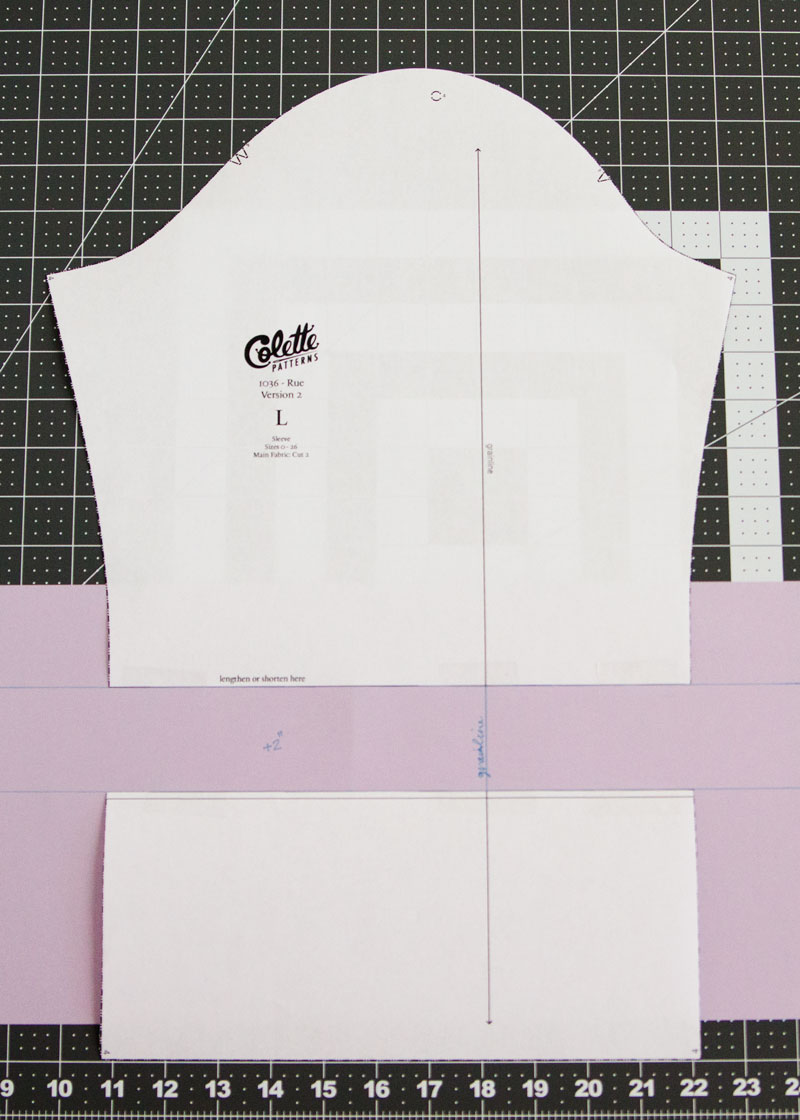
3. Bring your scrap piece of paper behind the slashed lines. Align your slashed pattern pieces with your lengthening guide and grainline. Tape to secure. Blend jagged edges and trim.
If you lengthen or shorten, make sure you do the same adjustment to all skirt pieces for your version.
Muslin
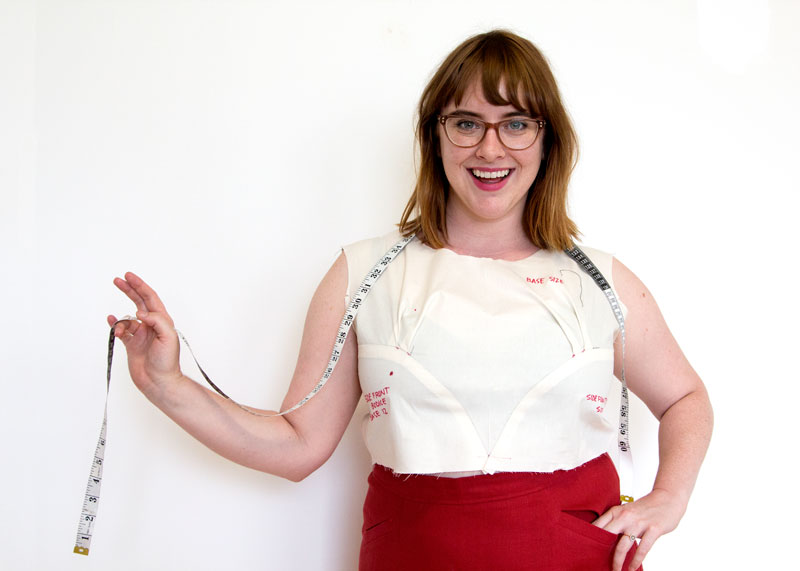
There are some things we can adjust in the flat paper before we cut any fabric, but at the end of the day, numbers can only tell us so much, as we all carry weight, length and width in different places. So it’s always helpful to make a muslin (also called a toile).
When making your muslin, remember that you do not need to do things like finish seams. It’s meant to be a quick and dirty mock-up so that you check the fit. Be sure to sew accurately, however, so that you’re getting a good idea of how a finished garment will look. You will also want to staystitsh the neckline so that it doesn’t stretch out as you’re trying it on.
Often times you can get away with just making a muslin of the bodice. It’s useful to still put a zipper in the center back so you can really see the fit. Remember, it can be a quick (baste it in so you can easily take it out to reuse it) and dirty (it doesn’t have to look good) zipper installation.
Alright, that’s it from this week! Next week, we’ll go over Bust Height Adjustment, Full/Small Bust Adjustment, and Narrow/Broad Shoulder Adjustments. It’ll be a doozy but you’ll learn so much! If you have any questions about what we went over today, leave a comment below!



Comments
Are the lining pattern pieces different from the main pieces or is it okay to just trace the main pieces and use to the lining as well? Thank you!
They are almost exactly the same. Except- the lining is 1/8″ shorter at the neckline.
What happens if your waist and hip measurements are essentially the same? And at the large end of the scale. For example, 54 and 54.
It’s possible for you to grade up in the hip from the size 26. Check out the Curvy Sewing Collective’s post on grading up in sizes for some helpful tips!
Thank you very much Katie
What about a 36 bust and 32 waist? Would you do a small bust adjustment?
Personally, I would choose a size 10 with a small bust adjustment. In a size 10 you would have 1″ of ease at the waist and if you wanted 1 1/2″ of ease in the bust all you would need to take out at the bust would be 1″.
For a 38 waist, and a 43 hip, I am in between sizes for both, how would you select and then what would you do? I have not cut any of my pattern yet! was planning on tracing onto new paper to avoid cutting .
Hey Courtney! I would choose a size 16, which would give you 1″ of ease in the waist. If you chose a size 18 you would have 4 inches at the hip, which is too much. Make a muslin to see if you would like to grade down at the hip, usually, it’s unesseasary, especially if you are sewing up version 1.
“Size blending is ideal for people who find that their hip falls into a larger size than their waist. ”
Ok, this I understand, but what happens if it is the contrary, this is the waist is in a larger size than the hips? I am always worried to blend sizes because the result is almost a straight line :-( How should I draw that without losing the general lines of the dress?
Thanks in advance!
Blending sizes from hip to waist can work both ways. I think it all depends on the silhouette. As someone who has only a 4″ difference between my waist and hip measurement, I prefer to wear silhouettes that have fullness at the hips to exaggerate my shape and make it seem like I actually have hips. If you are making Version 2, I would suggest making a muslin without blended sizes. If you decide, after the muslin, that you would like to grade, make sure to use a hip curve when re-drawing the side seam.
Ok so I made a muslin size 10 and graded to a 14 on the sides (I know that seems like a big size jump!) and it fits almost perfectly. I have narrow shoulders and a small bust, but I do carry some weight on my back.
The only fit issue I’m experiencing is a horizontal pulling on the bust. I do plan on doing the bust height adjustment so that the seam lies under my bust, but I’m wondering if I should try to cut a 12 on top? I’m a little concerned that if I do that I’ll have to adjust the shoulders.
Any advice on this?
Hey Jordynn! You may need a small bust adjustment. What is the difference between your finished bust measurement and your body’s bust measurement?
I’m 38.5″, so a 10. Should I do a 12 and do a small bust adjustment?
I think that is a good idea. Also, the problem may be that the 3.5″ of ease is too much for your body shape. Hold tight until Tuesday, when I go over the SBA. In the meantime, measure some semi-fitted dresses that you have and see what amounts of ease they each have. These measurements will help us make a more well-informed decision about decrease amounts in the SBA.
Sounds great – thanks Katie!
Ok, so I’ve made a size 12 – better fit and no pulling on the bust and I don’t need to adjust the bust height anymore. But I’ve got armhole and neckline gaping and the shoulders are too wide.
I’m eagerly awaiting the SBA and Narrow Shoulder adjustments!
Thanks for your help :)
Hopefully, the shoulder adjustment will fix that problem, I’ll go over those adjustments on Thursday.
If I’m 43″, 37″, 45″, should I just cut the size 16? I’m waiting for the next installment though as I typically need to make the bodice longer for height.
I suggest making a muslin in a size 16. In that size, you would have 4″ of ease in the bust, which is a bit too much. But, your waist would have a nice 2″ of ease. You will need to do a small bust adjustment in the size 16.
Thanks! :)
It looks like there is 4 inches of ease drafted in the bust and 3 in the waist. Should I size down from my body measurements (I am lucky in that all measurements are in one size) ?
Reference: 37, 29.5, 39
Sorry I intended to make that a separate comment. #iinternetlikeim80
Hey Laura! You are lucky! The size you choose depends on the amount of ease you prefer in your fitted dresses. If you cut a size 6 instead, you would have 3″ ease in the bust and 2″ in the waist, which I think would be plenty.
I am just a little larger than the size 26; my waist measurement is 52″ and my hips are 59.” Is it possible for me to make adjustments to make this fit, or am I out of luck?
Either way, I’m still going to follow along to learn the techniques you will be going over, but I’d really like to be able to make this dress and have it fit.
It’s possible for you to grade up in the hip from the size 26. Check out the Curvy Sewing Collective’s post on grading up in sizes for some helpful tips!
Hi Katie, I’m so excited to do this sewalong at the actual time rather than 2 years later! I’m planning to make version 1. My measurements are 5’2 tall, double D cup size, with highbust 32.5″, bust 35″, waist 29″, hips 36″. In past I would cut to match measurements without considering my DD cup and highbust measurements (i’m small boned so back measurement is smaller portion of the bust measurement, considering the cup size). This usually never works well because I always then have fit issues in topback, shoulders, across top of chest…I also tend to feel better in more fitted tops w/ less ease. I’m thinking maybe I should try cutting my muslin, as an experiment, to try a size 0 except grading at waist to a size 8, and then doing a FBA. Thoughts? Oh also, I haven’t printed pattern yet, but appears the waist of Rue sits slightly above the true waist, but is this the case?
Hey Viki! I would actually suggest that you make a muslin in a size 6, which would give you 2″ of ease in the waist. If you are sewing up Version 1 of Rue, grading down at the hip is most likely not necessary due to the fullness of the skirt. Even for Version 2, at a size 6, you would have 8 inches of ease, which you may like. I agree, an FBA is needed, Colette patterns are drafted for a C cup. Don’t worry, I’ll teach you all how to do an FBA on Tuesday.
Thank you so much for your input and I’m definitely going to follow your suggestion. I appreciate it.
My waist is 25″ and my hips are 36.” However, my bust is 30.5″ and my high bust is 30″. (Yes, it’s really hard to find bras.) So would I use a size 0 and blend to a size 2 at the hips? I used to have a 32B bust, but I lost weight there when I got older. The size 0 is for a 33″ bust, and actually has 37″ for the bust in the finished garment. Do you think the bust can be adjusted enough to fit me? I want to do version one. I also have a little middle aged tummy area below the waist, but I am hoping that version one is full enough in the skirt that it won’t show. I realize that I am probably older than your target audience, but I’m hoping that the dress design is classic enough that I won’t look grotesque.
Hello! First, I don’t think grading to a size 2 at the hips is necessary because the skirt is full for Version 1. As for the bust situation, I suggest sewing up a size 0 muslin with a small bust adjustment already done on the pattern. On a size 0, you will need to reduce the bust by 3.5″ if you would still like to have 3″ ease in the bust. I will be posting the small bust adjustment instructions on Tuesday.
When you try on the SBA muslin, you’ll be able to to see other places in the pattern in which more fabric needs to be taken in.
Hi Katie, I’m looking forward to making this pattern, if I can get the bust fitting correct, it should be flattering. My bust is 41.5″, waist is 35″ and hips are 40″, so I think I should try the size 14, although it may be too big through the shoulders.
Hey Cathy! I would suggest sizing down to a 12 because you are in between sizes and making a muslin! On Thursday, I will go over how to make adjustments for shoulders.
So excited for this sewalong, but I am very intimidated and am kinda panicking at how complex this pattern is/regretting getting myself into this (though excited and loving the challenge) . So I know I can think through what size to make, but I would like to know what you think. I am making version 1.
Measurements: B 36, W 34, H39
I wear a 32DDD, and am 5’1″.
Oh Rachael! I got your back and this will be great. Just be patient with yourself and follow along with me the best you can :)
Can you retake your measurements using these videos as a reference, (Bust measurements and Body Measurements), and let me know what you find?
Those videos were great.
OB 35.5
B. 38 ( I am nursing a baby, so I think that has shifted the size some today)
UB 31
W – smallest part right at bottom of rib cage 32
H 39
Neck to waist 15
Perfect! I would make a muslin in a size 10. You will still have 1″ of ease in the waist at this size and almost 4 inches of ease in the bust. You may need to decrease in the bust by a bit but let’s wait to see how the muslin turns out :)
Hi Katie, my mesurement are bust 34 with A cups, waist: 30 and hips 38. I think I will have a major bust ajustement next week! LOL!
My questions is; should I go with seize 10 and blend the hips to smaller seize or go with seize 6 and augmentate the waist? I’m going with the Version 2 of my Rue.
With all your nice explications, I will definitively make an muselin.
I suggest making a size 6 bodice muslin. In a size 6, you’ll have 1″ of ease at the waist, which may be enough room for you. Traditionally, smaller sizes need less ease than larger sizes. In the size 6, you will most likely not need to grade for the hips and you’ll definitely need a small bust adjustment. Don’t worry, my bust was off of the chart and I made it work!
Hi Katie,
My measurements are 33 bust, 29 waist and 38 hips. Should I use a size 6 or 8 – and do a small bust adjustment??
I would cut a size 6 muslin and do an SBA
Hi Katie. I’m usually an 18 in your patterns. But I just received my pattern in the mail yesterday. I’m looking at the CB to wait measurement and mine is 16″ where as the measurement for the size I usually wear is a 12. Is this why a lot of the dresses I’ve seen have the curved bust seam over the breast? I really would prefer it underneath the bust. Am I going to need to lengthen the pattern for general fit and then again so the bust seam fits under the bust? I’m not sure if this is a combination question on general fit and on a bust adjustment. Thanks.
Stephanie.
Also, I found some perfect red wool crepe in my stash that I think is going to look awesome. Would you think liking it with flannel would make it warmer? I’m in MN and it gets cold up here. I’d love to have a winter dress. Thanks again.
It is possible to alter the pattern to have the style line below your bust line. You’ll to need to lengthen the center front bodice, which I’ll go over tomorrow. In the meantime, make yourself a muslin and we will refer to it tomorrow :)
Hello Kate, I am looking at sewing Version 1. My bust is 41″, waist is 36″ and hips are 39″ I am thinking of doing a size 16 and add 1/4″ at the waist on each of the pattern pieces, then do a SBA – should I then grade the hips to size 12 to reduce the ease?
I suggest sewing up a muslin in the size 14, which would give you 1″ of ease in the waist. I would grade sizes in the hips to a size 8 and do a SBA.
When I made the Aster, the sewalong said the pattern was designed for a C cup and so I didn’t have to do a FBA. Is this dress pattern different? My bust is 40″ and waist 36″. What size should I choose and will I need to do a FBA?
Hello! Aster is a much simplier blouse and with the complexities of Rue’s bodice, I found it easier to base size selection on waist measurements verses bust. I would recommend that you sew up your muslin in a size 14, which would give you 1″ of ease in the waist and you’ll need a SBA.
Hi Katie,
my measurements are: B 36, W 30 and H 40.
Should I choose size 8 or 10?
Thanks
I would make a muslin in a size 8 and do a SBA. Thankfully, it will be a minor one :)
Hi Katie-
I’m curious to know the reason for choosing a size based on waist measurement, not high bust measurement, at least for the busty?
Does it have something to do with this particular pattern?
I’m asking because I’d like to understand when it might be a good idea to use this new-to-me approach, outside of the Rue, that is.
Hey Elizabeth! After a few fittings and size testing, basing size decisions on the waist measurement seemed to work best. On this pattern, due to the more advanced shaping on the bodice, choosing sizes based on waist guarantees that the most fitted part of the dress fits and alterations can be made from there.
Thanks!
Since we’re choosing based on waist size, am I correct in assuming that the waist seam will ride at the natural waist? Will you be covering torso length changes (beneath the bust)?
The waist of Rue lands at the natural waist. Yes, we will cover torso/bust height adjustments tomorrow ;)
Is there a way to attach or include photos in comments? I am having difficulty with the descriptive language I need to explain the issues I’m having with the bodice in a couple areas. If I could attach a photo it would be self explanatory. ?
Hey Jan, send the photos to service@colettepatterns.com with the subject line: Rue Fit Help and Meg or I will help you out :)
Thanks, Katie!
Katie —
I’m looking forward to your Height and FBA tutorials! Would you please make sure you cover how to adjust for someone quite tall? 5’10” (CB to waist 17 1/2″) HB: 38, FB: 44 (36DDD) W:37, H:46 I chose a size 16. I have always stumbled in combining both the height and FBA adjustments together – especially when combined with altering or moving darts. . . . Not knowing which to do first & how they relate to each other I’ve seemed to come up with a “frankenpatterns” and have never had the courage to actually try sewing them up.
I’m hoping that with your guidance I’ll be able to finally get a garment to fit!
Thank you!
Hey Lisa! The Busty posts are up! Let me know if you have any questions.
Hi,
Love the pattern, and found some stash fabric. Love the overall look – especially the bodice – Query: The neckline in the pictured muslin seems much different from the pattern – is it?
Noticed this as the pattern neckline is too wide for me and I’m wondering if there’s anything to look out for in changing it – the depth is OK – just way too wide. (It’s the overall shape that is wrong for me – I’m thinking the depth is fine).
I will be going over how to do shoulder width adjustments on Thursday :)
Hello Katie,
I’ve been following the sizing guidelines you’ve been discussing, and I wanted to see what size you would recommend for me. My measurements are Bust 37″, Waist 31″, and Hips 39″.
Thank you!
I suggest sewing up a muslin in a size 10. In that size, you will have 3″ of ease in the bust, 2″ of ease in the waist. After the muslin, you may decide to do a slight SBA to reduce the ease in the bust.
Hi! I’m ready to start muslining this and my measurements are 47.5, 43.5, and 48. Based on your comments to start with waist size, I’m between a 22 and 24, but the bust would be huge. Should I instead muslin a size 20 or would it be too snug in the waist? Thanks!
Hi Dana! I would sew up a muslin in a size size 22. You will have about 4″ of ease in the waist, which you might like. After you’ve sewn up your muslin, report back and I’ll help you from there!
It is obvious that to get a good fit, one needs to make a muslin. I look forward to trying this technique.
My measurements are bust: 37, waist: 40, hips: 43. I am 5’1″ Will I be blending sizes 8, 18 and 14?
If I get through this, it will be amazing. I have a beautiful organic cotton for the dress and silk habotai for the lining.
Hello! I would choose a size 18, based on your waist measurement. You’ll defiantly need a small bust adjustment, which you can find instructions for here.
I’m a 33 bust, 26 waist and 35.5 hip. Given the considerable ease in this pattern, should I cut out a size 0 and do a SBA?
Hello Katie, I do not understand the Measurements of the bust. Someone wrote, that she has a 36 bust and 32 waist. I have 36 ans 31. You recommended size 10. The waist ease would be 1 Inch, that I understand, but you wrote that she would Need only 1 Inch SBA if she wanted an ease of 1,5. but the measurement of the finished garment at the bust would be 42 inches. The difference is 6 inches, 1,5 inches for the ease remains 4,5 inches for the SBA, for my measurements the same. TThere must be something I do not understand, please help.
Hello, is there a possabillity to blend sizes between bust and waist? Even so I would cut out Size 6 for bodice Iwould have to make an alteration because of my small shoulders. The skirt I would cut out in Number 10. Is that possilble?